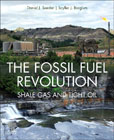
The Fossil Fuel Revolution: Shale Gas and Tight Oil
Soeder, Daniel J.
Borglum, Scyller J.
The Fossil Fuel Revolution: Shale Gas and Tight Oil describes the geologic life cycle of shale gas and tight oil. The book includes references for further reading and study problems to assess comprehension. Although shale is considered by many people to be a simple, uniform, and homogenous rock type, in reality it is variable and complex, which makes general characterizations of shale extremely difficult. The purpose of this book is to serve as a reference and resource on shale gas and tight oil for a broad spectrum of interested groups: industry members, undergraduate and graduate students, engineers and geoscientists. The Fossil Fuel Revolution: Shale Gas and Tight Oil includes case studies of shale plays located in North and South America, Europe, the Middle East, Asia, and Australia. Provides a cross-cutting view of shale gas and tight oil in the context of geology, petroleum engineering, and practical and economic industry aspectsIncludes a comprehensive list of shale case studies in one book, allowing readers to compare and contrast production from different shale playsFeatures an extensive resource list of peer-reviewed references, web sites, and journals provided at the end of each chapter, allowing readers to pursue a deeper understanding of the material INDICE: I. Geology of Tight Oil and Gas Shalesa. Petroleum Geology Conceptsi. Origins of Black Shalesii. Source Rocks1. Kerogen Types2. Thermal Maturationiii. Conventional Oil and Gas Resources1. Reservoir Rock2. Trap and Seal3. Migration Pathb. Unconventional Tight Oil and Shale Gas Resourcesi. Nature of Continuous Resource Playsii. The Challenges of Developmentiii. Natural Fracturesc. Resource Descriptionsi. Major U.S. Shale Plays1. Barnett Shale2. Fayetteville Shale3. Hainesville Shale4. Marcellus Shale5. Bakken Shale6. Niobrara Shale7. Utica Shale8. Eagle Ford Shale9. Woodford Shale10. Permian Basin11. Emerging Playsii. World Basins Shale Plays1. Canada and Mexico2. United Kingdom3. Continental Europe4. Russia5. Saudi Arabia and North Africa6. South Africa7. South America8. China and India9. AustraliaII. Oil and Gas Development Streama. Upstreami. Conventional Oil and Gas Developmentii. Unconventional Oil and Gas Developmentiii. Comparison of Shale Gas versus Tight Oil Productioniv. New Technologyb. Midstreami. Transportation - Rail, Pipeline, Truck, Shipii. Storage - Onshore and Offshorec. Downstreami. Primary Uses - Natural Gas1. Residential Use2. Electrical Generation3. Potential New Usesii. Primary Uses - Oil 1. Transportation Fuel2. Petrochemicals3. Other usesIII. Future of Fossil Fuelsa. Environmental Concernsi. Potential Environmental Impacts of Unconventional Oil & Gas Development1. Drilling Fluids and Frac Chemicals2. Produced Water3. Contamination Routesii. Green House Gas Emissions and Climate Changeb. Energy Economicsi. Cradle to Grave Responsibilityii. Context and Economics of Different Energy Sources1. Coal2. Natural Gas3. Petroleum4. Nuclear5. Geothermal6. Solar7. Wind (Offshore and Onshore)8. Biomass iii. Energy Densityc. Energy Security
- ISBN: 978-0-12-815397-0
- Editorial: Elsevier
- Encuadernacion: Rústica
- Páginas: 350
- Fecha Publicación: 01/09/2019
- Nº Volúmenes: 1
- Idioma: Inglés
